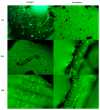The Characterization and Study of Antibacterial, Free Radical Scavenging, and Anticancer Potential of Livistona chinensis-Mediated Silver Nanoparticles
- PMID: 38067504
- PMCID: PMC10708060
- DOI: 10.3390/molecules28237773
The Characterization and Study of Antibacterial, Free Radical Scavenging, and Anticancer Potential of Livistona chinensis-Mediated Silver Nanoparticles
Abstract
In the present research, Livistona chinensis leaf extracts were utilized as reductants to bio-fabricate silver nanoparticles (LC-AgNPs) and this was followed by the evaluation of their antioxidant, antibacterial, and anticancer potential. Multiple parameters were optimized for the formation and fidelity of LC-AgNPs. The color shift of the reaction mixture from yellow to dark brown confirmed the LC-AgNPs formation. UV/VIS spectroscopy exhibited a surface plasmon resonance (SPR) band at 436 nm. The Fourier transform infrared (FTIR) spectroscopy spectrum depicted phytochemicals in the plant extract acting as bio-reducers for LC-AgNPs synthesis. The XRD pattern confirmed the presence of LC-AgNPs by showing peaks corresponding to 2θ angle at 8.24° (111), 38.16° (200), 44.20° (220), and 64.72° (311). Zetasizer analysis exhibited size distribution by intensity of LC-AgNPs with a mean value of 255.7 d. nm. Moreover, the zeta potential indicated that the AgNPs synthesized were stable. The irregular shape of LC-AgNPs with a mean average of 38.46 ± 0.26 nm was found by scanning electron microscopy. Furthermore, the antioxidant potential of LC-AgNPs was examined using a DPPH assay and was calculated to be higher in LC-AgNPs than in leaf extracts. The calculated IC50 values of the LC-AgNPs and plant extract are 85.01 ± 0.17 and 209.44 ± 0.24, respectively. The antibacterial activity of LC-AgNPs was investigated against Escherichia coli, Pseudomonas aeruginosa, and Bacillus subtilis as well as Staphylococcus aureus, and maximum potential was observed after 24 h against P. aeruginosa. Moreover, LC-AgNPs exhibited maximum anticancer potential against TPC1 cell lines compared to the plant extract. The findings suggested that LC-AgNPs could be used as antioxidant, antibacterial, and anticancer agents for the cure of free-radical-oriented bacterial and oncogenic diseases.
Keywords: AgNPs; DPPH; Livistona chinensis; green synthesis; reactive oxygen species; thyroid cancer cells.
Conflict of interest statement
The authors declare no conflict of interest.
Figures













Similar articles
-
Biosynthesis and characterization of silver nanoparticles from Asplenium dalhousiae and their potential biological properties.PLoS One. 2025 Jun 30;20(6):e0325533. doi: 10.1371/journal.pone.0325533. eCollection 2025. PLoS One. 2025. PMID: 40587502 Free PMC article.
-
Green synthesis of silver nanoparticles from plant Astragalus fasciculifolius Bioss and evaluating cytotoxic effects on MCF7 human breast cancer cells.Sci Rep. 2025 Jul 15;15(1):25474. doi: 10.1038/s41598-025-05224-5. Sci Rep. 2025. PMID: 40664749 Free PMC article.
-
Structural insights and biomedical potential of biosynthesized silver nanoparticles: antibacterial activity, anti-biofilm and cancer cell inhibition.PeerJ. 2025 Jul 1;13:e19608. doi: 10.7717/peerj.19608. eCollection 2025. PeerJ. 2025. PMID: 40620779 Free PMC article.
-
Intravenous magnesium sulphate and sotalol for prevention of atrial fibrillation after coronary artery bypass surgery: a systematic review and economic evaluation.Health Technol Assess. 2008 Jun;12(28):iii-iv, ix-95. doi: 10.3310/hta12280. Health Technol Assess. 2008. PMID: 18547499
-
An evidence-based environmental perspective of manufactured silver nanoparticle in syntheses and applications: a systematic review and critical appraisal of peer-reviewed scientific papers.Sci Total Environ. 2010 Feb 1;408(5):999-1006. doi: 10.1016/j.scitotenv.2009.11.003. Epub 2009 Nov 27. Sci Total Environ. 2010. PMID: 19945151
Cited by
-
Effects of Trace Elements on Endocrine Function and Pathogenesis of Thyroid Diseases-A Literature Review.Nutrients. 2025 Jan 22;17(3):398. doi: 10.3390/nu17030398. Nutrients. 2025. PMID: 39940256 Free PMC article. Review.
-
Photocatalytic removal of textile wastewater-originated methylene blue and malachite green dyes using spent black tea extract-coated silver nanoparticles.Sci Rep. 2025 Jan 13;15(1):1851. doi: 10.1038/s41598-025-85894-3. Sci Rep. 2025. PMID: 39805978 Free PMC article.
References
-
- Ali B.A., Azeem M.A., Qayyum A., Mustafa G., Ahmad M.A., Javed M.T., Chaudhary H.J. Sustainable Agriculture Reviews 53. Springer; Berlin/Heidelberg, Germany: 2021. Bio-Fabricated Silver Nanoparticles: A Sustainable Approach for Augmentation of Plant Growth and Pathogen Control; pp. 345–371.
-
- Faryal S., Ullah R., Khan M.N., Ali B., Hafeez A., Jaremko M., Qureshi K.A. Thiourea-Capped Nanoapatites Amplify Osmotic Stress Tolerance in Zea mays L. by Conserving Photosynthetic Pigments, Osmolytes Biosynthesis and Antioxidant Biosystems. Molecules. 2022;27:5744. doi: 10.3390/molecules27185744. - DOI - PMC - PubMed
-
- Saratale R.G., Benelli G., Kumar G., Kim D.S., Saratale G.D. Bio-fabrication of silver nanoparticles using the leaf extract of an ancient herbal medicine, dandelion (Taraxacum officinale), evaluation of their antioxidant, anticancer potential, and antimicrobial activity against phytopathogens. Environ. Sci. Pollut. Res. 2018;25:10392–10406. doi: 10.1007/s11356-017-9581-5. - DOI - PubMed
-
- Mobin M., Ahmad I., Shoeb M. Investigation into the highly efficient Artemisia absinthium-silver nanoparticles composite as a novel environmentally benign corrosion inhibitor for mild steel in 1M HCl. J. Adhes. Sci. Technol. 2022;36:2562–2587. doi: 10.1080/01694243.2022.2075523. - DOI
MeSH terms
Substances
LinkOut - more resources
Full Text Sources

